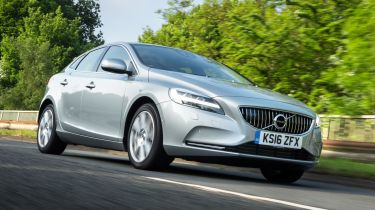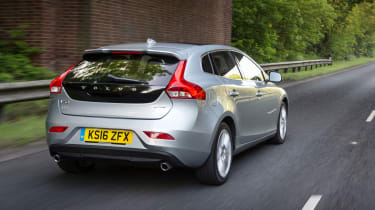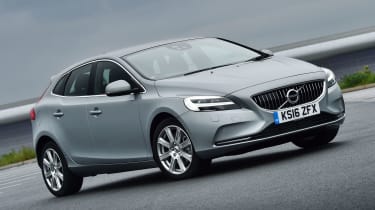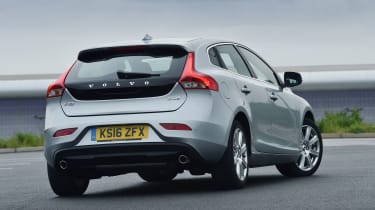New Volvo V40 2016 review
With an XC90-inspired facelift, can the Volvo V40 take the fight to premium rivals like the BMW 1 Series and Audi A3?

The new XC90, S90 and V90 have shown Volvo is back at its best, but the V40 is feeling its age and falls down against rivals in several key areas. Its interior is cramped and dated in its appearance, while space in the back and boot can’t compete in such a tough class. It’s stylish, efficient and good to drive, but a similarly priced Audi or BMW – or indeed a cheaper Vauxhall Astra – seems a more logical choice.
The Volvo V40 sits in a very competitive class. The segment is awash with premium family cars such as the BMW 1 Series and Audi A3 – and with models like the new Vauxhall Astra and Mazda 3 taking a step upmarket, deciding which to buy is perhaps not as simple as it once was.
But to keep things competitive, Volvo has tweaked its smallest model for 2016. The changes are most evident from the front, where the designers have implemented the XC90’s now familiar ‘Thor’s Hammer’ headlights, offering a much bolder signature with bright LED daytime running lights. All cars also get a larger badge on the grille, and a better integrated radar sensor for the automatic emergency braking and radar cruise control.
You’d be hard pushed to tell the new and old cars apart from the rear, but that’s no bad thing as the updated model retains its predecessor’s fresh features with the familiar darkened tailgate and tall light clusters. Even our entry-level D2 gets dual exhausts, so save for the badging on the bootlid, your colleagues would be none-the-wiser if you opted for this entry-level eco model.
Used - available now

2026 Porsche
Macan
18,900 milesAutomaticPetrol2.0L
Cash £47,000
2023 Jaguar
E-PACE
23,959 milesAutomaticDiesel2.0L
Cash £31,250
2021 Ford
EcoSport
12,435 milesManualPetrol1.0L
Cash £13,902
2022 Ford
EcoSport
20,987 milesManualPetrol1.0L
Cash £12,813Inside, it’s a shame to see Volvo carry over the cluttered centre console with a myriad of buttons sitting beneath the standard five-inch screen. Existing owners will be used to the confusing setup, but for newcomers it could be enough to send them fleeing to the nearest Mercedes showroom.
It’s all beautifully finished, though, with plenty of soft-touch materials lining the dash and doors. The digital instrument cluster is clear and easy to read, while all the switches operate with a satisfying quality. The joystick-style gearlever remains, as does the old-fashioned long-pull handbrake.
On the road, the D2 is still our pick, offering rock-bottom running costs with adequate performance. The 89g/km CO2 emissions are extremely competitive in this class, while headline fuel economy of 84.1mpg should be enough to tempt plenty of high mileage drivers. No Audi A3 comes close – though it’s worth noting that the bigger wheels on some R Design models will push CO2 emissions to 94g/km.
The V40 is good, if a little unexciting to drive. The D2 engine can feel a little laggy around town, but leave it in a lower gear and there’s enough shove from the four-cylinder diesel. The 0-62mph sprint takes 10.5 seconds, which is actually two-tenths faster than an Audi A3 1.6 TDI – though you’d be hard pushed to tell the two apart in mixed motoring.
While the engine can feel a little harsh and breathless under hard acceleration, it settles down nicely on the motorway. It’s super smooth and remarkably refined at high speeds – especially on the smaller 16 or 17-inch wheels. We’ve not tried one in the popular V40 R Design spec yet, but there’s a chance the wider rims will affect cabin noise on rougher surfaces.
Find a twistier stretch of tarmac and you’ll be pleased by how agile the Volvo feels. The steering isn’t super precise, but it’s got a fine chassis and body roll is kept in check. There was enough travel in the suspension on our entry-level Momentum to ensure it remained comfortable at all times, too, making it feel much more grown up than a BMW 1 Series.
Unfortunately, while the V40 is a match for its class rivals in terms of style and handling, it can’t match the best for practicality. The boot is disappointingly small (324 litres), while visibility is compromised – especially with the bulky rear headrests in their upright position. The sloping roofline impacts space in the back, too, so those regularly carrying taller passengers might be better off with a well-specced VW Golf.












